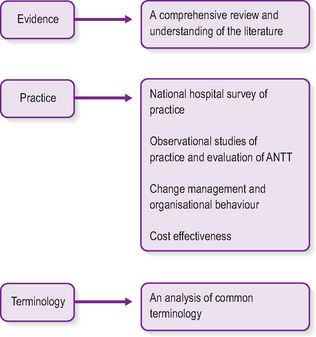Chapter 34 Aseptic non-touch technique
INTRODUCTION
Every year it is estimated that as many as 5000 patients die unnecessarily in the UK as a direct result of healthcare associated infection (HCAI), and as many as 15 000 may die as an indirect result of infections they acquired from healthcare settings (National Audit Office 2000). Many of these infections are due to poor aseptic technique. Aseptic non-touch technique (ANTT) is an evidence-based aseptic technique, based on a theoretical framework and growing evidence base (Fig. 34.1). The principles of ANTT are applicable to all clinical procedures, such as wound dressing, catheterisation and intravenous (i.v.) therapy. Intravenous therapies are particularly important, as they are among the most commonly performed aseptic procedures in hospitals today and often provide the most direct infection risk to the patient. The principals of ANTT are increasingly acknowledged as the basis of good aseptic practice and as part of Department of Health (DoH) guidance for the prevention of HCAI (DoH epic2 2007).
RATIONALE
Why does ANTT work?
First, staff are taught to identify and protect the key parts of any procedure, perform effective hand washing, institute a non-touch technique, wear only appropriate and necessary protective equipment (COSHH 2002), and use the most applicable infective precautions; implementing these actions in a logical order. Second, by introducing ANTT as an audit cycle using quality resources, staff are trained and retrained on an ongoing basis. In typical ward-based teams, these two approaches combined with patient involvement have the added value of creating a degree of peer pressure, which further helps promote standardised practice.
FACTORS TO NOTE
Correct use of terminology
Other terms, such as ‘sterile’ and ‘clean technique’, are often used inaccurately and can confuse practitioners (Box 34.1).
BOX 34.1 Terminology should accurately reflect practice
Sterile techniques – are not achievable
The word sterile means ‘free from microorganisms’ (Weller 1993). Therefore, due to the natural multitude of microorganisms in the atmosphere it is not possible to achieve a true sterile technique for procedures in typical ward/home environments.
Aseptic techniques – are achievable
For infections to occur in the bloodstream (in i.v. therapy) or local sites (in wound care, etc.), key parts or sites must be contaminated by a sufficient number of virulent, pathogenic organisms (Hendrick 1988). Therefore, a technique that prevents this level of contamination is safe. Such a technique is most accurately termed an ‘aseptic technique’, as the word asepsis means ‘freedom from infection or infectious (pathogenic) material’ (Weller 1993).
Non-touch techniques – are paramount
Pathogenic organisms cannot always be removed by effective hand washing (Church 1986). Additionally, hand washing is not always effective (Mallett & Dougherty 2000). Therefore, a non-touch technique is perhaps the single most important component in achieving asepsis.
Equity in intravenous care
In intravenous therapy, ANTT should be used for both central and peripheral line care (see Ch. 41).
Healthy, sick and handicapped children
The definition or principles of the aseptic non-touch technique are not dependent on the diagnosis of the child. The principles of ANTT should always remain constant, although the infective precautions may change depending on the type of procedure and the technical difficulty involved in maintaining asepsis. According to Jones (1987), an ideal aseptic technique for intravenous catheter care is one that is safe and effective, yet requires a minimal amount of time and equipment. Choosing appropriate infective precautions for any particular procedure is achieved by an effective assessment of ‘risk’. If the nurse considers that asepsis of key parts/sites cannot be maintained by a non-touch method, further steps must be taken to minimise the risk of contamination. This might entail the use of extra precautions such as forceps or sterile gloves.
A review of the literature indicated that aseptic techniques have evolved more from anecdotal evidence and ritualistic practice than from empirical research. In addition, the principles of aseptic technique require reappraising in nursing practice (Lund & Caruso 1993). These two factors underpin the theoretical framework of ANTT and emphasise the need for its simple, pragmatic and robust research base.
EVIDENCE: IMPORTANT COMPONENTS OF ANTT
HAND WASHING
Hand washing is the most important and central component of ANTT (NPSA website: www.npsa.nhs.uk). On each square centimetre of the skin, there may be as many as 3 million bacteria (Gould 1991a) and new research suggests that as many as 182 species of bacteria are present on the skin (Gao 2007). Some are normal or resident skin flora and some are transient organisms that can be carried on the skin for weeks or months (Gould 1991a). Studies have demonstrated the ability of pathogenic organisms to survive and breed on the hands of healthcare workers (Adams & Marrie 1982, Bauer et al 1990). Effective hand washing can significantly decrease bacterial counts (Leonard 1986, Rossoff et al 1995, Pittet et al 1999, 2000, Girou et al 2002, Lucet et al 2002). Effective hand hygiene and washing is as important both before and after glove use when bacterial counts will have rapidly risen (increased) in the warm humid environment created under gloves (Larson 1989, Gould 1991a, Pittet et al 1999, Pratt 2007, CDC 2002). Stringer et al (1991) found that failure to wash hands after the removal of gloves was one of the most common breakdowns in universal precautions. Further information on hand washing can be found in Chapter 4.
Hand cleansing has been identified as the single most significant procedure in preventing cross-infection (Maki et al 1973, Thomlinson 1990, Gould 1991a, Girou et al 2002, Cochrane 2003); however, paradoxically, despite these widely known facts, healthcare workers continue to exhibit poor compliance with effective hand cleansing practices (Thomlinson 1990, Gallagher 1999, Pittet et al 1999). The reasons for this remain complex and multifaceted including:
Stay updated, free articles. Join our Telegram channel

Full access? Get Clinical Tree



